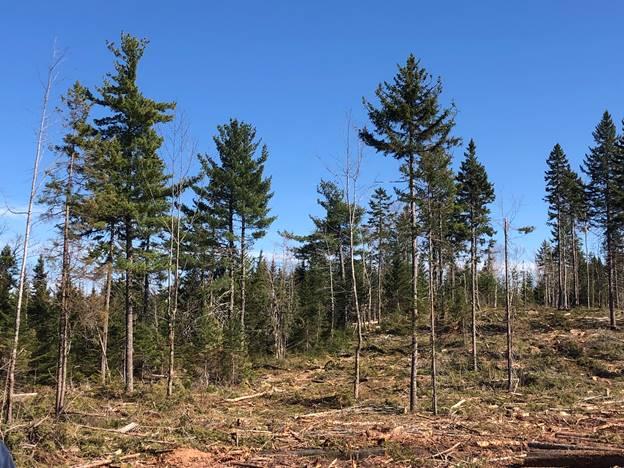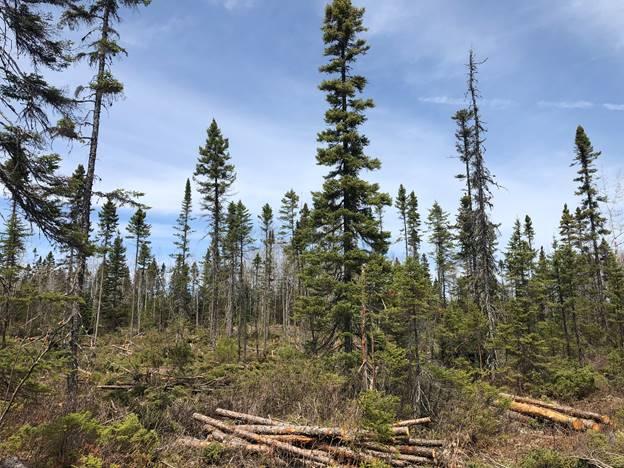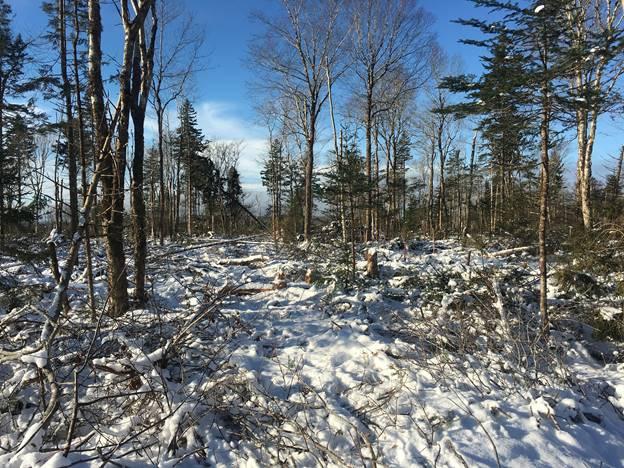Addendum on Aug 18, 2019
It’s not multi-age management and it’s not a substitute for implementing Irregular Shelterwood systems as recommended by Lahey and Seymour

L&F’s illustration of A “variable retention prescription with 10% retention left standing”. The latest HPMV notification cites 91% of the proposed harvests on 350 ha as VR 10%.
As of July 18, 2019, L&F made a “minor” update in the HPMV. From the e-mail sent out on July 18, 2019 to subscribers to map update notifications (see Harvest Operation Maps webpage to subscribe):
…the Harvest Plans Map Viewer (HPMV) will receive a minor update on July 18, 2019. The update involves labelling the percent retention of proposed plans with a Variable Retention (VR) prescription.
The percent retention of these proposed plans will be seen in two locations:
1. When zoomed in on a VR prescribed proposed harvest plan, the phrase “Variable Retention – x% will be seen beneath the block identifying number.
2. After selecting a proposed plan that is open for comment a text box will pop-up providing additional information. In that information box the prescription field will read “Variable Retention – x%”.
On February 5, 2019 a message was sent to the Harvest Plans Map Viewer distribution list providing two prescription definitions, not currently in the Forest Management Guide. One of those prescriptions was Variable Retention (VR). The VR prescription was introduced on the HPMV in conjunction with the release of the Interim Retention Guide, which was part of the governments December 2018 response to the Forest Practices Report by Professor Lahey. The Interim Retention Guide provides practical and specific guidance to department staff, Licensees and the public on how the department is shifting its policies to focus on an Ecology first forest management model within the Matrix part of the Triad.
The departments definition of Variable Retention is a silvicultural system that retains forest structural elements for at least one rotation in order to preserve environmental values associated with structurally complex forests. In Nova Scotia, the implementation of the “Interim Retention Guide” dictates the amount of retention required as well as the type of trees to be retained (https://novascotia.ca/natr/forestry/Forest_Review/Retention-Guide-NS-Crown-Land.pdf).
To help users understand what a Variable Retention prescription looks like on the ground please refer to the following pictures that list three levels of retention – 10%, 20% & 30%.
Figure 1: A variable retention prescription with 10% retention left standing.
Figure 2: A variable retention prescription with 20% retention left standing.Figure 3: A variable retention prescription with 30% retention left standing.
For the three Harvest Plan announcements since L&F started specifying the %Retention, here are some summary stats:
——–
It is beginning to look as though the “Interim” in the Interim Retention Guide is becoming permanent.
Variable Retention (VR) is not, as I understand it, regarded as a method of multi-age management.
From my reading of the Interim Retention Guidelines, Recommendations of Lahey, and comments by Robert Seymour (view From Lahey), I was expecting VR to be a stop-gap measure, while the FMG, PTA etc are revised to implement irregular shelterwood systems as the major or default choice for management on Crown land forests, at least within the matrix of the Triad system.
From the Introduction to the Interim Retention Guide:
To implement these recommendations, it is proposed that a two-phase approach be used. A comprehensive revision of the existing Forest Management Guide, to incorporate new treatments such as “Irregular Shelterwoods”, will require a longer-term effort. Time is required to incorporate these new prescriptions into the existing Forest Management Guide framework and to make the changes required in the data collection and summary tools used to produce and evaluate Forest Harvest Plans. While this work is being conducted, an Interim Retention Guide is being introduced, in the short-term, to address recommendations to increase retention in situations where the Forest Management Guide currently prescribes Clearcuts (Overstory Removals and Seed Tree Harvests). In this way, the objectives identified in the Forestry Review to increase retention and promote multi-aged and multi-species forests can be supported while waiting for the longer-term changes to the Forest Management Guide framework.
Says Robert Seymour in the Addendum to the Independent Review (bolding is mine):
Multi‐aged systems of silviculture appear to be unfamiliar or novel to many Nova Scotian foresters, especially the variants of irregular shelterwood (Raymond et al. 2009; Seymour 2017) that are so flexible in replicating natural forest dynamics while still producing significant volumes of timber economically. Irregular shelterwood is not even mentioned in the new Forest Management Guide (McGrath 2018), and it is not among the practices that qualify for silviculture funding under the Nova Scotia Registry of Buyers system.
The critical step in addressing this issue is the revision of the Forest Management Guide, described in considerable detail in Section 14.4. We recommend that this be done as a small‐group project using a team of foresters from the region experienced in natural forest management. This is too large a task for
any single individual. The Guide in its current form is highly prescriptive and would likely benefit from relaxing many of the detailed decision criteria while keeping within clearly defined ecological sideboards. It is also a large, highly technical reference (as it should be) aimed at professional foresters
for making rigorous silvicultural decisions and, as such, will tend to become the “last word” on silviculture in Nova Scotia. Such a format is not readily accessible to landowners without forestry training, so we urge that a much‐simplified version, emphasizing the benefits of multi‐aged silviculture for both wood production and ecosystem conservation, be developed.…If forest management in Nova Scotia were truly ecosystem based, using natural disturbance regimes and other ecological science to guide silvicultural decision making, one would expect the Forest Management Guide to prescribe multi‐aged silvicultural systems on the vast majority of the natural forest landscape. As described below, this appears not to be the case. Here, multi‐aged silviculture is defined, following O’Hara (2014), as any system that creates and maintains stand structures with two or more age classes. Multi‐aged silviculture is thus not limited to classical single‐tree selection cutting, but rather includes a broad array of two‐ and three‐aged systems as would be maintained under irregular shelterwood systems, which are arguably better suited to most conditions than balanced selection systems (Raymond et al. 2009; Raymond and Bedard 2017; Arsenault et al. 2011; Seymour 1994, 2005, 2017).
Prof. Seymour’s comments in the first paragraph above are rather remarkable, given that his silvicultural concepts were highlighted and promoted by Bancroft an Crossland in the Natural Resources Strategy 2010; clearly the professional foresters at DNR/L&F must have been well aware of them. Do they really need so much time to finally implement them now that the Government/L&F have accepted the related recommendations in the Lahey Report?
Even as a stop-gap measure while L&F figures out how to apply Irregular Shelterwood harvesting, I cannot see how the VR (Variable Retention) as illustrated above – with more or less evenly spaced, single trees retained – preserves “environmental values associated with structurally complex forests”, e.g., features such as a multilayered canopy, groups of trees and snags on pit and mound topography, variable distribution of individual trees and clumps of trees including big living and big standing dead trees and big dead trees lying on the forest floor in various stages of decomposition, native ground layer vegetation…
Do the examples in Figs 1,2 and 3 above illustrate
“VRH [which] approaches focus on retaining mature live trees in a range of spatial configurations across a harvested area in an attempt to emulate the post‐disturbance legacies historically characterizing forests following meso‐ and stand‐scale disturbances As such, VRH is designed to create a diversity of microhabitats, including open habitat and mature forest structures, which presumably provide the range of conditions necessary to maintain ground‐layer biodiversity in forests managed for wood products.” – MW Roberts et al., Long‐term impacts of variable retention harvesting on ground‐layer plant communities in Pinus resinosa forests in Journal of Applied Ecology 2016. ?
Roberts et al. were concerned about continuity of the ground layer vegetation in particular and noted “the levels of retention are greater than those generally recommended by guidelines in many regions of the world (Gustafsson et al. 2012), and we would expect even greater departures from ground‐layer conditions found in intact stands if such lower levels were employed in these systems. As such, managers aiming to minimize diversity losses may want to employ retention levels above those generally recommended by site‐level guidelines.”
A recent paper* describes how structural complexity is a good predictor of total photosynthesis and carbon sequestration – although it seems we don’t even want to talk about carbon sequestration as a criterion for harvest decisions in NS forests.
I wish I could be more positive about L&F’s efforts re: Ecological Forestry Implementation as we approach the one year anniversary of the release of the Lahey Report (Aug 21, 2019).
Perhaps the revelations expected as the L&F Project Teams begin to roll out their proposed changes and “engaging stakeholders and the public” related to the department’s “foundational priorities”** will be more encouraging.
Addendum Aug 18, 2019:
In a document I have just seen – Discussion Paper, Summary of Proposed Policy Direction and Revisions to the Forest Management Guide and Pre-Treatment Assessment Process, L&F Aug 13, 2019, distributed to invitees to a workshop on the FMG – it is proposed to “Introduce new prescriptions, including:
o Variable Retention (10% and 25% retention treatments)
o Salvage with Retention (10% retention)
o Irregular Shelterwood (45% retention).”
Say the authors, “The proposed changes would promote a wider range of ecologically based multi-aged silvicultural systems (including irregular shelterwood harvests2), while ensuring some form of post-harvest retention levels are maintained for all present and future single-aged prescriptions.”
_________
Footnote 2 reads: “2 Irregular shelterwoods are a hybrid between selection harvests and regular shelterwood harvests. Both rely on shade to promote regeneration, but unlike regular shelterwoods, the overstory is retained for a longer period in irregular shelterwoods which creates a multi-aged stand structure.”
‘Will have to wait and see the nuances of the proposed changes, and to clarify to what extent VR would remain the most common prescription as it is currently, re stats in Table above. Clearly L&F should be moving much more quickly to implement multi-age prescriptions as the standard, with VR permitted only under exceptional circumstances and otherwise only in the Intensive Forestry leg of the Triad.
_____________________
*Christopher M. Gough, Jeff W. Atkins, Robert T. Fahey, Brady S. Hardiman. High rates of primary production in structurally complex forests. Ecology, 2019; DOI: 10.1002/ecy.2864.
Abstract: Structure‐function relationships are central to many ecological paradigms. Chief among these is the linkage of net primary production (NPP) with species diversity and canopy structure. Using the National Ecological Observatory Network (NEON) as a subcontinental‐scale research platform, we examined how temperate forest NPP relates to several measures of site‐level canopy structure and tree species diversity. Novel multi‐dimensional canopy traits describing structural complexity, most notably canopy rugosity, were more strongly related to site NPP than were species diversity measures and other commonly characterized canopy structural features. The amount of variation in site‐level NPP explained by canopy rugosity alone was 83%, which was substantially greater than that explained individually by vegetation area index (31%) or Shannon’s Index of species diversity (30%). Forests that were more structurally complex, had higher vegetation area indices, or were more diverse absorbed more light and used light more efficiently to power biomass production, but these relationships were most strongly tied to structural complexity. Implications for ecosystem modeling and management are wide‐ranging, suggesting structural complexity traits are broad, mechanistically‐robust indicators of NPP that, in application, could improve the prediction and management of temperate forest carbon sequestration.
___________
** Foundational Priorities
– FOREST MANAGEMENT GUIDE
– HIGH-PRODUCTION FORESTRY
– NATURAL DISTURBANCE REGIMES
– OLD FOREST
– OUTCOMES-BASED FOREST MANAGEMENT
– REPORTING ON THE STATE OF THE FOREST
– SMALL SCALE WOOD ENERGY INITIATIVE
– SPECIES AT RISK PROGRAM RENEWAL
I kind of wonder what happened to
– Landscape Level Planning for Biodiversity Conservation
(highlighted in Lahey Report)
– Soil/aquatic acidification
(Mentioned in Lahey Report)
– Carbon sequestration/Bioenergy Carbon accounting
(Not mentioned in Lahey Report)
———-
Some related pages and posts on NSFN
– “When is a Clearcut still a Clearcut?” in Nova Scotia 26Feb2019
– Recent changes (Jan 30 & Feb 20, 2019) in Harvest Plan Map Viewer increase concerns about clearcutting in Nova Scotia
Post, Feb 24, 2019.
– Nova Scotia L&F “eliminates clearcutting” – the word that is
Feb 20, 2019.
– Nova Scotia L&F Minister Rankin: “clearcut is just a layman term” 14Mar2019






